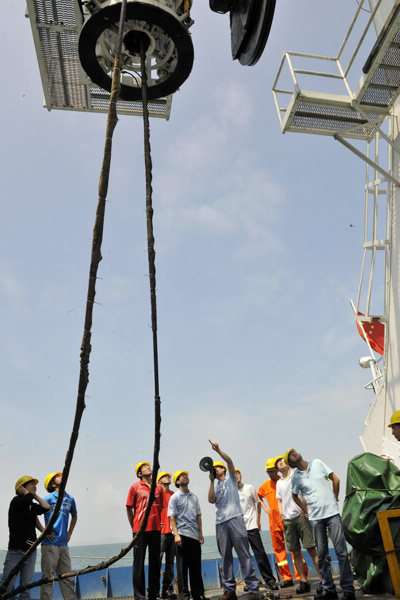|
 |
|
EXPEDITION: Crew members work on the Chinese research vessel Haiyang-6 in the South China Sea on June 4. The vessel set off two days earlier from south China's Guangzhou on a four-month ocean research program (ZHOU WENJIE) |
The diplomatic row over the Huangyan Island in the South China Sea is gradually quieting down as neither China nor the Philippines wants the situation to escalate, and the rest of the world is cautious about direct involvement.
Observers say a kind of balance might be maintained for a period of time on the issue as all parties involved have revealed their hands.
"The attitude of Washington toward the issue is strategic. It is very cautious and will not be overreacting. Philippine President Benigno Aquino III doesn't have any other card to play," said Tang Qifang, a researcher on Southeast Asian studies with the China Institute of International Studies. "China will not make any concession on the sovereignty of Huangyan Island. It will insist on resolving the issue through dialogue, which China believes is the only way to reach a win-win result for both sides."
Island crisis
On April 10, the Philippines sent a warship to harass 12 Chinese fishing vessels that had sailed into the lagoon of Huangyan Island to shelter from bad weather.
The Philippines, which claims sovereignty over the island, also asserted it would take the dispute over the island to international arbitration. In addition, it tried to rename the island and remove the signs and monuments related to China.
Huangyan Island, which is made up of a group of reefs and islets, is about 900 km from Hainan Island in south China. Its lagoon has long provided shelter for Chinese fishing boats.
The Chinese Government sent patrol ships to Huangyan Island to rescue the fishermen immediately after the harassment occurred. Chinese administrative vessels remain deployed near the Island to watch over the waters. While protecting its sovereignty from the Philippines' challenges, the Chinese Government showed self-restraint.
In a recent article published in The Straits Times of Singapore, Chinese Vice Foreign Minister Fu Ying said Huangyan Island has always belonged to China. China expects to solve the dispute with the Philippines through consultation and is making endeavors to this end. Fu was a former Chinese ambassador to Manila (1998-2000).
"If armed conflict broke out between China and the Philippines, big damage could be brought to both countries and the two peoples would suffer," Tang said.
The difference between the two countries on the South China Sea islands is, of course, not the whole of Sino-Philippine relations. Addressing the dispute through bilateral diplomatic consultation shows China is a responsible country, said Li Guoqiang, Deputy Director of the Research Center for Chinese Borderland History and Geography at the Chinese Academy of Social Sciences.
Fu's article was published at a time when defense officials, experts and scholars from Asia-Pacific countries gathered at the Asia Security Summit in Singapore to discuss and reflect on how to build lasting security in East Asia. The summit is also known as the Shangri-La Dialogue.
U.S. Defense Secretary Leon Panetta, who attended the summit, called for the Sino-Philippine dispute to be resolved through dialogue.
"We call for restraint and for diplomatic resolution. We oppose provocation, we oppose coercion and we oppose the use of force. We do not take sides when it comes to competing territorial claims," Panetta said.
"The United States' high-profile 'return' to the Asia-Pacific region is on a strategic level. The Philippines is only one of the chess pieces of the U.S. strategy. Under the current situation, it is impossible that Washington would take more steps except the symbolic mobilization of warships," Tang told Beijing Review.
In addition, the Philippine proposal in recent years of establishing a "zone of peace, freedom, friendship and cooperation" in the South China Sea region did not receive a positive reaction among other Southeast Asian countries.
| 